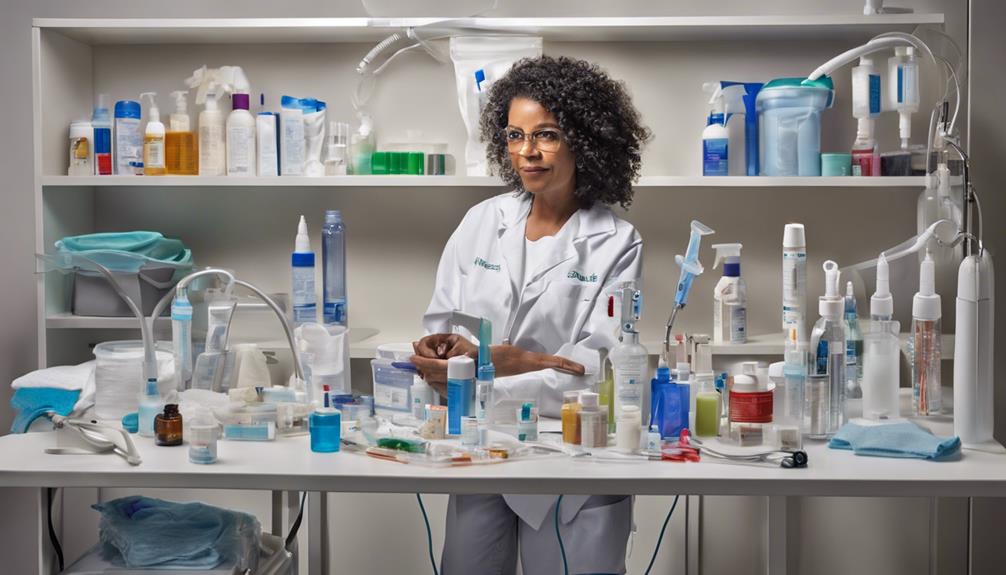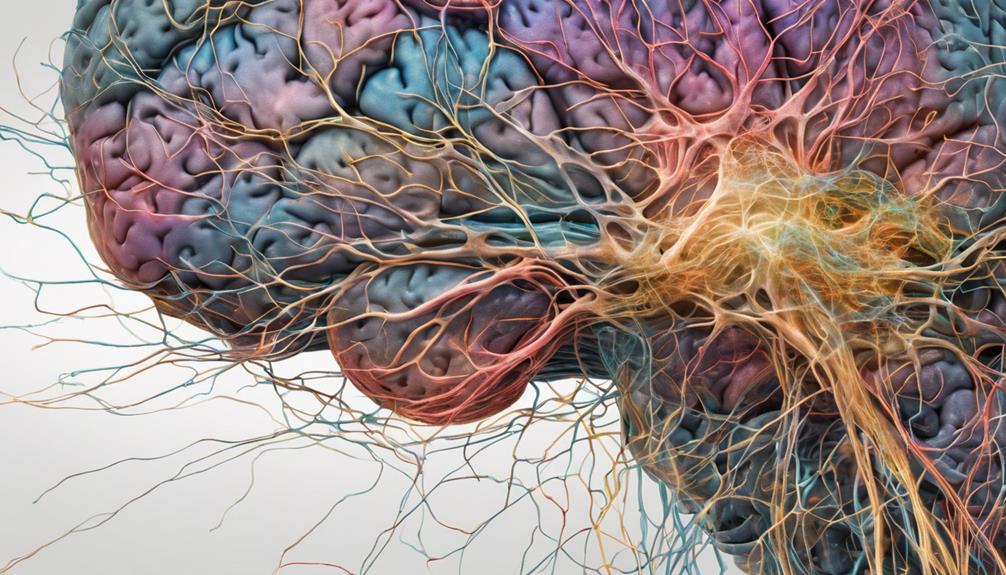To care for feeding tubes at home, it is important to store supplies in a cool, dry place and regularly check expiration dates. Before touching the supplies, wash your hands and regularly check for tube dislodgement. Make sure the feedings are at room temperature to prevent cramping. Always keep spare supplies on hand and ensure that the equipment is functioning properly. Monitor the skin and gastric health closely for any issues. Seek immediate medical help for any complications. Keep an eye on weight changes and digestive problems. Watch out for signs of infection or blockage. Remember, careful home care is essential for the patient’s safety and well-being. For more helpful tips, click here!
Key Takeaways
- Proper storage of feeding tube products is crucial for safety and effectiveness.
- Maintain good hand hygiene when handling supplies to prevent contamination.
- Ensure feeding is at room temperature to prevent discomfort and aid digestion.
- Regularly monitor equipment for wear and tear to prevent malfunctions.
- Promptly address complications like infections or dislodgements for patient safety.
Storage of Feeding Tube Products
When managing feeding tube products, we must store unopened items at room temperature to maintain their integrity. It's important to keep these items away from direct sunlight or heat sources to prevent any potential damage. Extreme temperature fluctuations should also be avoided as they can impact the quality of the feeding tube products. Checking the expiration dates on these products is essential, and any expired items should be promptly discarded to guarantee safety.
Opened feeding tube products should be stored in the refrigerator and used within the recommended timeframe to guarantee freshness and safety. By following these storage guidelines, we can make sure that the feeding tube products remain effective and safe for consumption. Proper storage not only maintains the integrity of the items but also helps in preventing any potential risks associated with expired products. Remember, a well-organized and controlled storage system is important for the overall care and well-being of individuals relying on feeding tube products.
Hand Hygiene and Supplies Handling

Ensuring proper hand hygiene and handling of supplies is essential in maintaining the cleanliness and safety of feeding tube equipment. Before touching any feeding tube supplies, it's critical to wash our hands thoroughly with soap and water to prevent contamination.
If necessary, disposable gloves should be used when handling feeding tube equipment to uphold good hygiene practices. By keeping feeding tube supplies in a clean and organized area, we can prevent cross-contamination and guarantee the safety of the equipment.
It's important to store unused feeding tube supplies in a dry and cool place to maintain their integrity and effectiveness. Regularly checking the expiration dates on feeding tube supplies is also crucial to ensure their safety and efficacy in providing proper nutrition.
Temperature of Feedings
Maintaining the ideal temperature of feeding tube formula is essential for the comfort and digestion of patients. When it comes to feeding tube management, ensuring the correct temperature can make a significant difference in the well-being of the individual. Here are some key points to contemplate regarding the temperature of feedings:
- Feeding tube formula should be at room temperature before administration to prevent any potential discomfort for the patient.
- Cold feedings can lead to stomach cramping and unease, affecting the overall digestion process.
- Warm feedings can help relax the stomach muscles, promoting smoother digestion and overall comfort for the patient.
Equipment Readiness and Availability
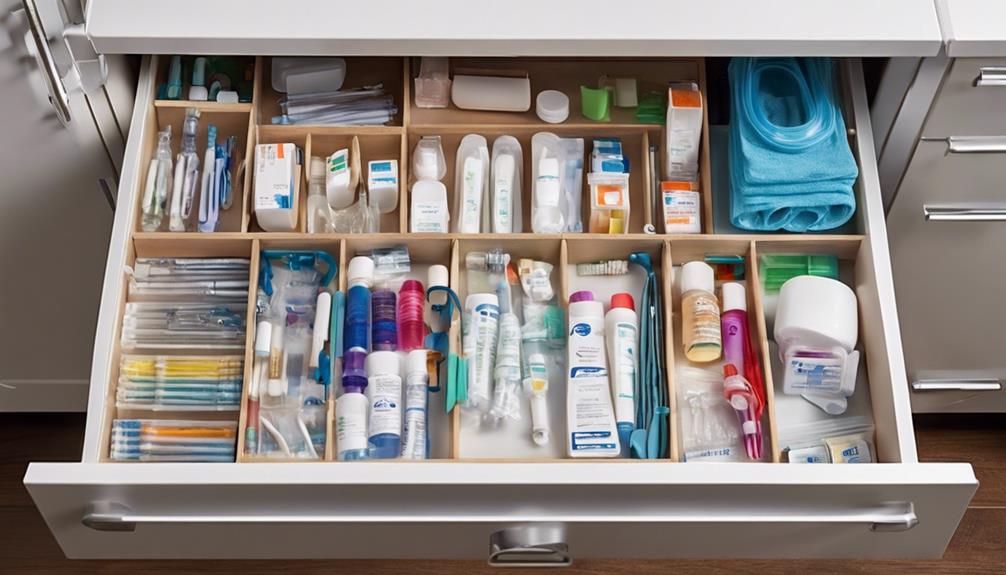
Let's make sure we've spare feeding tubes, extension sets, syringes, and cleaning supplies always within reach.
It's essential to keep a stock of the recommended formula or liquid nutrition for continuous care.
Having a well-maintained feeding pump or gravity bag system is vital for precise and controlled feedings.
Equipment Maintenance Tips
Keeping feeding tube equipment readily available and in good working condition is crucial for effective home care management. To guarantee your equipment is always ready for use, follow these maintenance tips:
- Regularly inspect all feeding tube equipment for wear or damage.
- Store supplies in a clean and organized manner for easy access.
- Maintain a backup stock of essential equipment to prevent any care interruptions.
Emergency Preparedness Strategies
In emergency situations, having a backup feeding tube readily available is essential for guaranteeing continuous care. It is critical to keep essential supplies like extension sets, syringes, and cleaning materials organized and well-stocked. Here is a table outlining key equipment readiness and availability strategies:
| Equipment Readiness Strategies | Backup Feeding Tube | Essential Supplies |
|---|---|---|
| Check functionality regularly | Have a spare tube on hand | Stock extension sets, syringes, and cleaning materials |
| Plan for accessing medical support | Store in a safe, accessible place | Keep supplies organized and easily accessible |
| Familiarize with troubleshooting steps | Ensure proper size and type | Regularly check expiration dates |
Being prepared with these strategies and troubleshooting steps can help handle emergencies effectively and maintain the continuity of care.
Monitoring Patients Condition
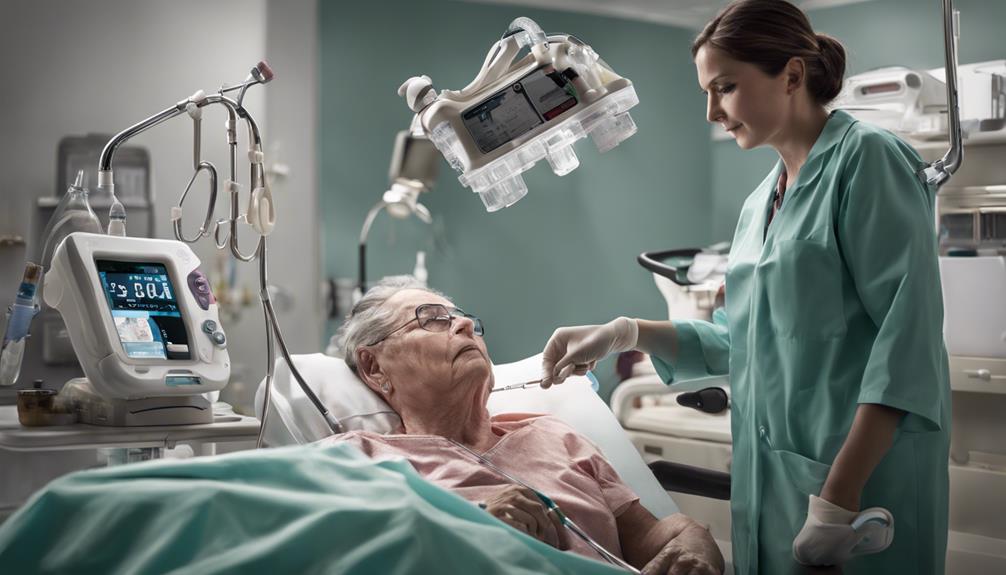
Regular monitoring of the patient's condition is essential for ensuring the best management of feeding tubes. Here are three key aspects to focus on when monitoring a patient with a feeding tube:
- Gastric Emptying: Keep track of how well the stomach is emptying its contents after a feeding. Slow gastric emptying can lead to complications such as reflux or aspiration.
- Skin Integrity: Regularly check the skin around the tube insertion site for any signs of pressure injuries or breakdown. Maintaining skin integrity is critical to prevent infections.
- Complications: Monitor for any complications that may arise, such as infections, tube dislodgement, or clogging. Promptly addressing these issues is essential for the patient's well-being.
Adjusting Feeding Schedules

When managing a feeding tube at home, it's important to take into account the timing of feedings and guarantee meal consistency. These factors can play a significant role in meeting the patient's nutritional needs and overall health.
Adjusting feeding schedules based on healthcare provider recommendations is vital for ideal nutrition and well-being.
Timing Considerations
Consistently adjusting feeding schedules based on individual needs is crucial for optimizing the effectiveness of nutritional support provided through feeding tube management.
When considering timing considerations for feeding tube care, it's important to:
- Tailor feeding schedules to align with the individual's activity level, metabolism, and medical condition.
- Seek guidance from healthcare providers to establish the best timing for feeding tube administration, ensuring proper nutrient absorption.
- Make necessary adjustments to feeding times to accommodate other daily activities, medications, or therapies.
Meal Consistency
To optimize nutritional support through feeding tube management, adjusting meal consistency based on individual tolerance and nutritional needs is essential.
Consistency in meal timing plays an important role in regulating digestion and nutrient absorption for individuals reliant on tube feeding. It's significant to space out feeds appropriately to prevent complications such as reflux or aspiration.
Consulting with a healthcare provider is recommended when considering adjustments to feeding schedules to guarantee ideal nutrition.
Monitoring for signs of intolerance or discomfort during and after feeding sessions is crucial for the overall well-being of the individual.
Recognizing Complications
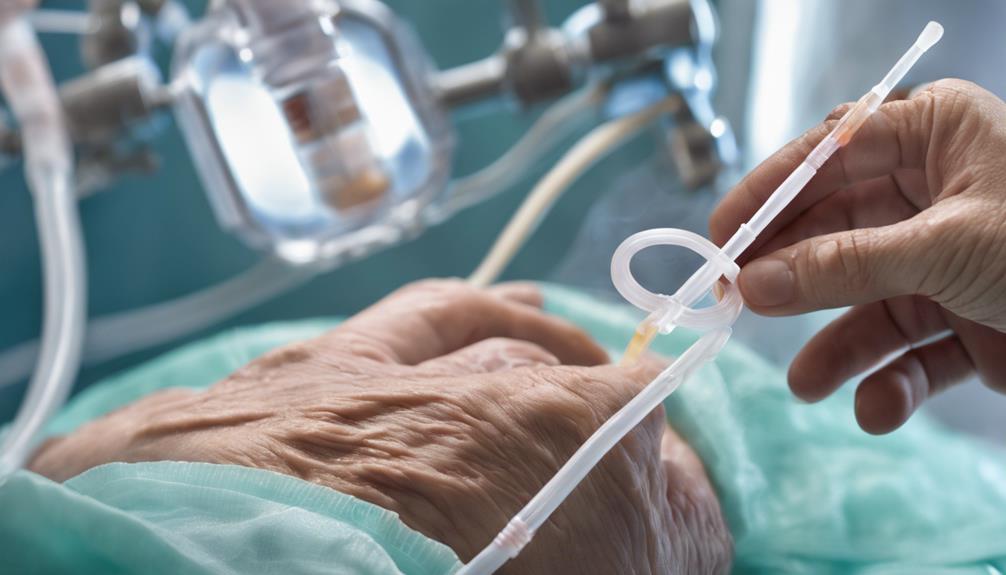
Recognizing complications associated with feeding tubes is essential for ensuring timely intervention and maintaining the patient's health and safety. Caregivers must be vigilant for signs of tube dislodgement, infection, skin irritation, and blockages. Here are three key points to help you recognize complications effectively:
- Tube Dislodgement: Keep an eye out for any unexpected movement or changes in the position of the feeding tube. If you notice the tube has shifted or is no longer in the correct place, seek assistance promptly to prevent further complications.
- Infection: Watch for redness, tenderness, fever, or unusual drainage around the tube site. If you observe any signs of infection, such as pus or increased redness, seek medical attention immediately to prevent the infection from spreading.
- Skin Irritation: Check the skin around the tube site for any redness, irritation, or breakdown. Proper care and cleaning of the skin can help prevent skin issues and discomfort for the patient.
Prompt Medical Intervention
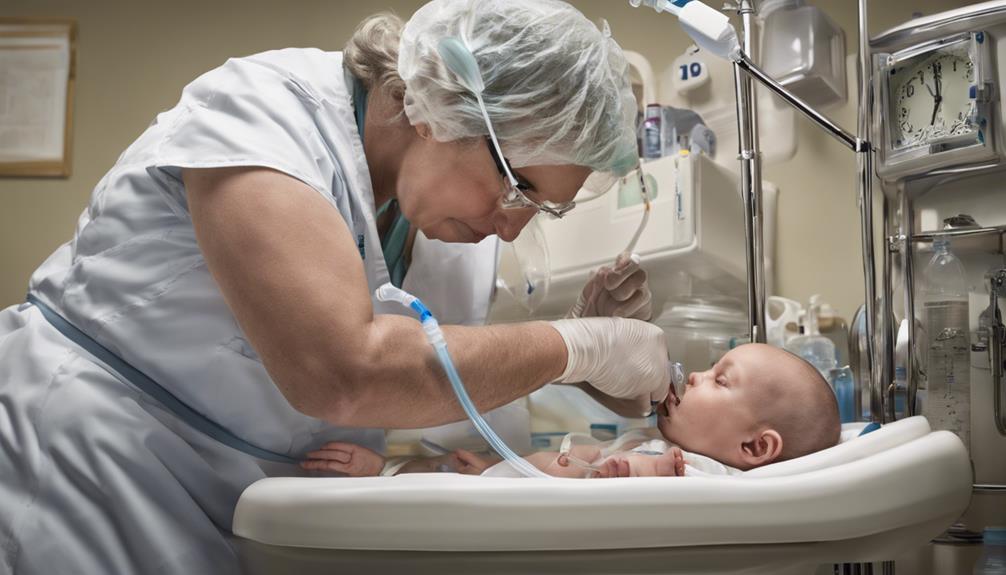
Prompt medical intervention is essential when managing a feeding tube. If you notice any signs of infection or if the tube becomes loose, seek immediate medical attention.
Timely Medical Attention
Seeking immediate medical assistance for any issues related to feeding tube management is essential to prevent complications and guarantee effective care. When faced with tube dislodgement, blockages, or infections, timely intervention is critical.
Here are three key reasons why prompt medical attention is important:
- Preventing Further Problems: Immediate help for redness, irritation, leakage, or clogs can stop issues from escalating.
- Improving Outcomes: Early detection and treatment of feeding tube-related problems lead to better patient results.
- Saving Lives: Quick medical response to tube-related emergencies can be life-saving and prevent serious consequences.
Urgent Care Coordination
Coordinating urgent medical care for feeding tube complications is essential to guaranteeing patient safety and well-being.
If there's a clog in the feeding tube, immediate attention is critical to prevent complications and guarantee proper nutrition delivery.
Seek urgent care coordination if the feeding tube becomes displaced or dislodged to avoid potential harm to the patient.
Contact healthcare providers promptly if there's leakage at the site of the feeding tube to address the issue and prevent skin irritation or infection.
Additionally, if there's excessive gastric residual volume or signs of tube feeding intolerance, it's crucial to seek urgent medical guidance for appropriate management.
Acting promptly in these situations is key to maintaining the health and well-being of individuals with feeding tubes.
Rapid Response Plan
During emergencies involving feeding tube complications, immediate action is vital to guarantee patient safety and prevent serious complications. A rapid response plan ensures prompt medical intervention for feeding tube-related emergencies, including tube dislodgement, blockage, and signs of infection.
To effectively implement this plan, caregivers must be trained on the specific steps to follow in case of an emergency. Having clear instructions and emergency contact information readily available is essential for quick access to medical assistance. Additionally, it’s important to ensure that any necessary **assisted living home modifications** are in place to improve safety and accessibility during emergencies. These modifications might include installing handrails, widening doorways, or adding ramps to facilitate quick evacuation. A well-prepared environment coupled with trained caregivers can significantly reduce response times and improve overall outcomes in urgent situations.
Weight Changes and Digestive Issues
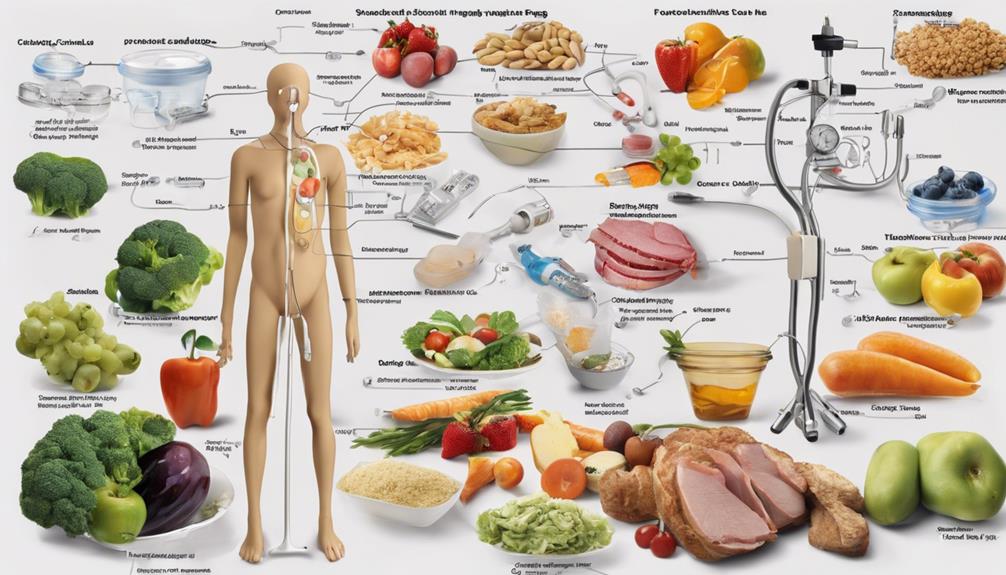
Monitoring weight changes and digestive issues is vital in managing feeding tubes to guarantee proper nutrition and hydration. Weight changes in tube-fed patients can signal problems with nutrition or fluid balance, highlighting the need for close monitoring and potential adjustments to the feeding regimen.
Similarly, digestive issues such as diarrhea or constipation can arise from improper feeding tube management, underscoring the importance of adequate hydration and dietary modifications.
Regularly monitoring stool consistency and frequency is essential for promptly identifying and addressing digestive problems in individuals with feeding tubes. Any changes in bowel habits, abdominal discomfort, or bloating should be promptly reported to healthcare providers for evaluation and potential modifications to the treatment plan.
Keeping a food diary and tracking symptoms can aid in recognizing patterns related to weight changes and digestive issues, facilitating better management of feeding tube care. By staying vigilant and proactive in monitoring these aspects, caregivers can help ensure the well-being of individuals relying on feeding tubes for their nutritional needs.
Signs of Complications

To ensure the well-being of individuals with feeding tubes, identifying signs of complications such as redness, swelling, or drainage at the insertion site is vital for prompt intervention. When caring for someone with a feeding tube, it's essential to be vigilant for any indications of potential issues. Here are three key signs of complications to watch out for:
- Increased pain, discomfort, or leakage around the tube can indicate a problem that needs attention.
- Symptoms such as fever, chills, or foul-smelling discharge should be reported to healthcare providers promptly for further evaluation.
- Nausea, vomiting, or changes in bowel movements may indicate underlying issues with the feeding tube that require assessment.
Frequently Asked Questions
How Do You Care for Someone With a Feeding Tube at Home?
We guarantee proper care for individuals with feeding tubes at home. Clean the site regularly, flush the tube before and after feedings, secure it during activities, and monitor for issues. Notify healthcare providers of any concerns promptly for best care.
What Care Is Needed for a Feeding Tube?
We guarantee feeding tube care includes regular changes and daily tasks like washing syringes, checking pH, measuring tube length, and observing content appearance. We uphold oral hygiene, secure the tube, and store excess milk.
What Are Important Aspects of Care Regarding Tube Feeding?
Ensuring proper positioning during feeding, regular tube flushing, and maintaining oral hygiene are essential. Monitoring signs of displacement and seeking help promptly is crucial. Following a structured care routine, including medication administration and site care, ensures successful tube feeding management.
How Can I Manage My NG Tube at Home?
We maintain our NG tube at home through regular changes, flushing after feedings, measuring tube length, keeping spares for emergencies, and maintaining oral hygiene. These steps guarantee proper care, prevent clogs, displacement, and infections, promoting excellent feeding tube health.
Conclusion
As we conclude, remember that proper home care for feeding tube management is vital for the health and well-being of your loved one. By following the essential steps outlined in this article, you can guarantee that the feeding tube is being properly maintained and the patient's condition is being monitored closely.
Stay vigilant and proactive in recognizing any complications that may arise, and always seek prompt medical intervention when needed. Your attention to detail and care can make a significant difference in the patient's overall health and comfort.
